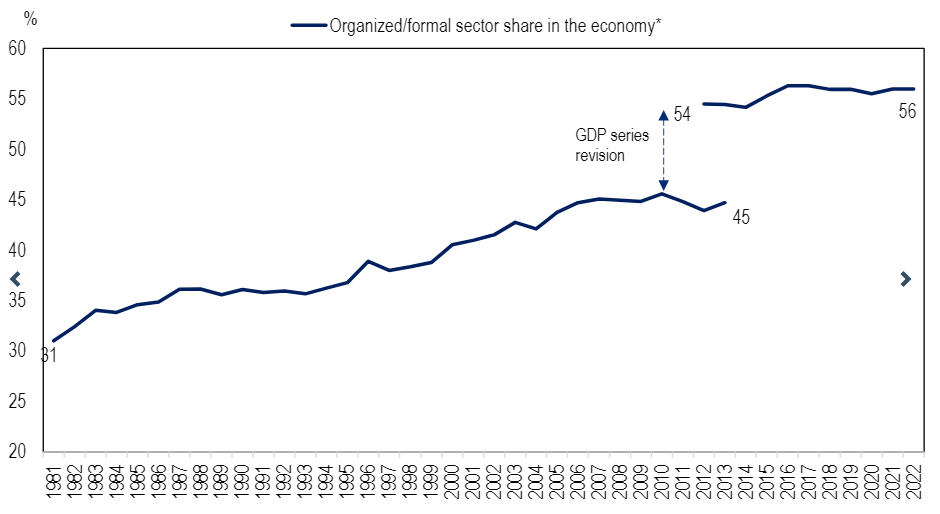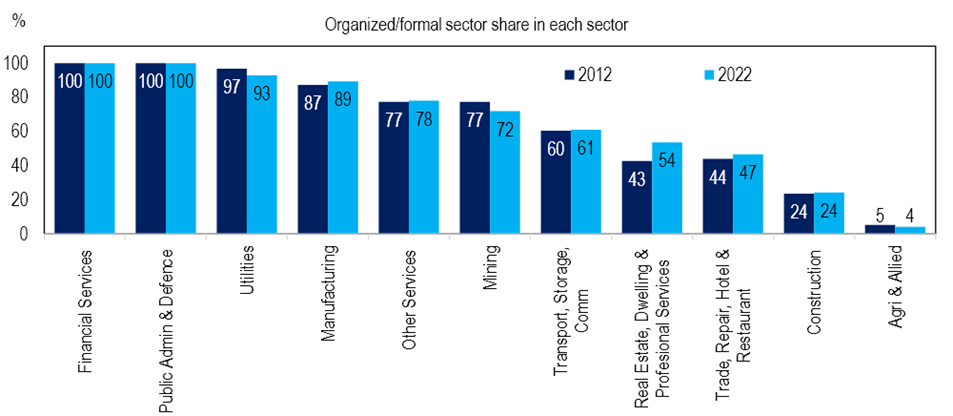
A recent report from Citi Research’s Samiran Chakraborty and team looks at India’s long march to formalisation. Progress has been made, but there is also a long way left to go.
The so-called formalization of the Indian economy has been a defining feature of recent decades. Often pinned as a factor behind India’s growth outperformance, received wisdom is that it has accelerated recently.
The problem is it can be hard to quantify that acceleration given a lack of a clear definition of formalization and the tendency to adopt different concepts across multiple sectors. Compounding this is that the benefits of formalization in terms of efficiency gains and worker benefits can vary across sectors.
Figure 1. The share of the formal sector in the Indian economy has risen to 56%
© 2024 Citigroup Inc. No redistribution without Citigroup’s written permission.
Source: Citi Research, MoSPI. *Definition of formal sector was changed in the new GDP series. In the new definition, quasi corporates are now considered to be part of the formal sector.
The Citi Research report starts with a macro perspective on formalization, followed by sector-specific nuances, leading to a section looking at companies for which the process of formalisation has proven to be a boon. The analysis suggests that the formal share of GDP has increased to 56% now, a jump of more than 25pp over the past four decades with almost 90% of manufacturing formalized.
Mixed trends of formalization are seen in the labor market. The number of workers in the formal sector has almost doubled in the past 15 years, but overall formalization in the labor market is still quite low at ~15% with an overdependence on agriculture.
Figure2. India: Formalization by Sector
© 2024 Citigroup Inc. No redistribution without Citigroup’s written permission.
Source: Citi Research, MoSPI
A surge in overall employment occurred post-Covid, with 54 million new jobs in 3 years, but was almost entirely through self-employed workers, suggesting scant improvement in formalization.
The process of labor market formalization is incomplete, but large wage differentials between formal and informal jobs imply that labor market formalization would have significant benefits on household incomes and consumption patterns in the future, the full Citi Research report says. It also says that in the manufacturing sector, which is mostly “formal”, the degree of formalization increases with firm size (based on numbers of workers) and higher formalization leads to improved productivity and better chances of growth.
The proportion of small firms in India remains much higher than global standards.
Widening of the taxation ecosystem could be another measure of formalization where India has witnessed significant improvement for both direct and indirect taxes. Although there are only 90 million individual taxpayers (~6.6% of the population), 4.4 million people have been brought into the tax net annually in the past decade, partly because of improved compliance.
Gains from formalization are also seen in the form of larger allocation of household savings into productive financial assets.
Here are a few indicators of the march of formalisation in India:
- The number of individual taxpayers increased from 51 million in 2013 to 90 million in 2022.
- The annual increase in the number of taxpayers over past decade has been 4.4 million vis-à-vis an addition to salaried employees of 2.9 million.
- The top 2% of income earning individuals who paid taxes accounted for more than 40% of the tax collected. The bottom 75% of individuals accounted for just ~15%.
- Total number of workers in the formal sector almost doubled from ~47 million in 2005 to 88 million in 2019 – with ~25% of non-agri jobs in the formal sector now.
- Over the past two decades, the number of salaried workers has doubled to ~122 million now.
- Post-pandemic, while total employment is up by ~40 million, formal employment has fallen by ~4 million to around 84 million by FY23.
- India added around 54 million jobs between FY23 (latest) and FY20 (pre-Covid) and around half of the new non-agri jobs in this period (28 million) were created in the construction sector.
- Female workers account for almost three-fourths of new self-employed jobs in the post-Covid period.
- Formal sector wages are 2.5 times higher than informal wages.
For more information on the future of India’s formalisation from an economic, market, and labor standpoint, please see the full report (dated 18 January 2024) here if you are a Velocity subscriber: India Multi-Asset - The Many Shades of Formalization: A Path to Prosperity.
Citi Global Insights (CGI) is Citi’s premier non-independent thought leadership curation. It is not investment research; however, it may contain thematic content previously expressed in an Independent Research report. For the full CGI disclosure, click here.




